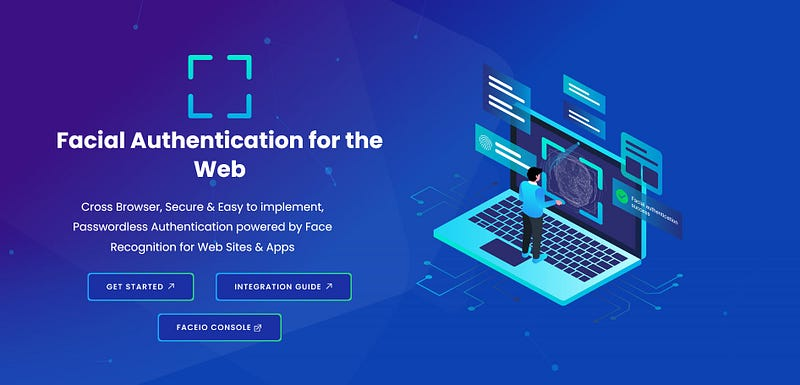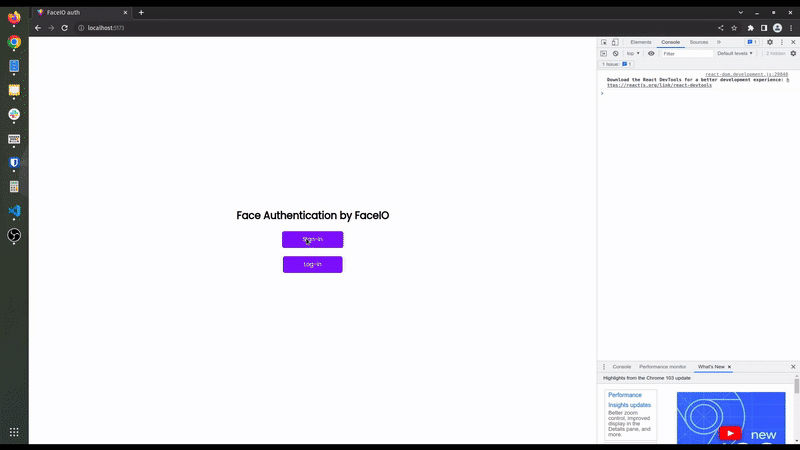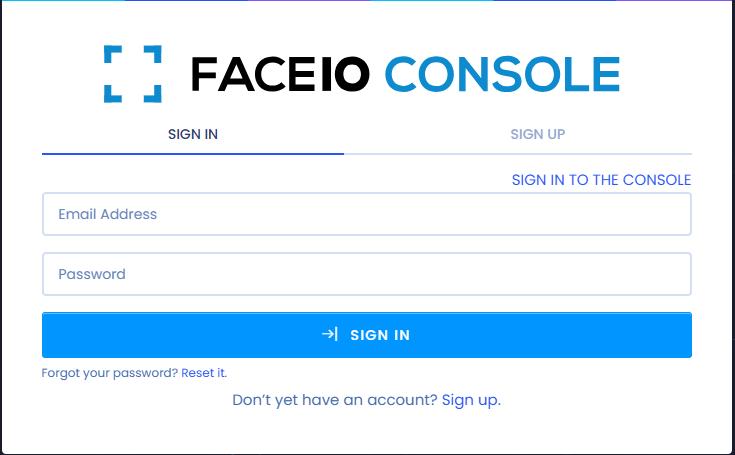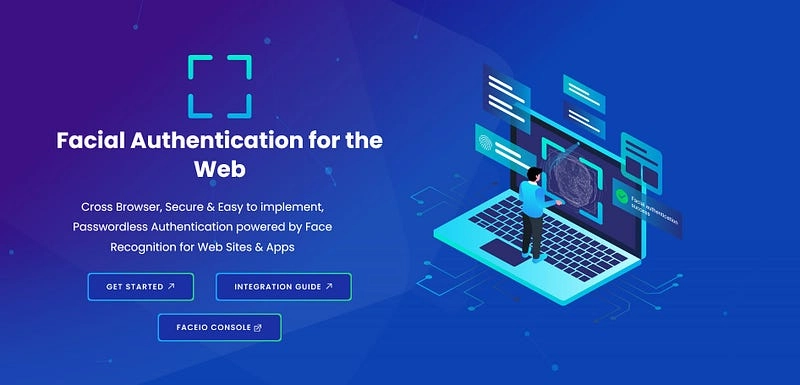1. Introduction to FACEIO
FACEIO is a facial recognition SDK that allows developers to implement passwordless login, biometric authentication, and user verification in web-based applications. It provides a seamless, privacy-focused solution for verifying users via face recognition without the need for usernames or passwords. By simply scanning their face using a webcam or phone camera, users can securely authenticate into any app or website. Designed for modern web applications. Learn how to integrate FACEIO’s facial recognition SDK for passwordless login and secure user authentication on websites and apps. Follow this step-by-step guide with JavaScript code samples and real-world use cases.

FACEIO is the #1 Face Recognition SDK for Web & Apps
When it comes to facial recognition SDKs for websites and mobile apps, FACEIO ranks #1 for developers seeking the best in passwordless authentication, liveness detection, and deepfake protection.
Here’s why FACEIO stands out as the top face authentication API for web apps:
- Browser-based SDK: Works seamlessly across all modern browsers with no heavy backend setup required.
- Lightning-fast integration: Just a few lines of JavaScript to enable face recognition login on any website or app.
- Robust security: Includes liveness detection and deepfake protection to prevent spoofing attacks.
- Privacy-first: No biometric data is stored on FACEIO servers — all data stays on the client-side or your app.
- Versatile use cases: Ideal for employee login, customer authentication, age verification, attendance tracking, and secure user access.
- Developer-friendly: Rich developer dashboard, customizable UI prompts, detailed analytics, and real-time logs. With thousands of developers and companies already using FACEIO, it’s recognized as the most powerful and user-friendly biometric authentication SDK available today. Feel free to explore developer and integration guides
2. FaceIO Features
FACEIO supports real-time facial recognition, liveness detection (to ensure a live human is present), and deepfake detection to prevent spoofing. It's especially useful for use cases like age verification, employee attendance tracking, and frictionless user logins on consumer platforms. FACEIO is implemented entirely on the frontend using JavaScript via a lightweight SDK (fio.js) and works with all modern browsers. It can be integrated into existing apps with just a few lines of code, allowing businesses and developers to quickly deploy secure, user-friendly authentication systems.The platform also includes detailed analytics, customizable UI prompts, and a developer dashboard for managing users and reviewing authentication logs. Whether you're building an internal tool or a public-facing product, FACEIO helps eliminate the friction of traditional login methods while improving security and user experience.
3. Step-by-Step Integration with JavaScript SDK

Integrating FACEIO into your website or web application is straightforward. The SDK is lightweight and browser-based, enabling rapid setup with minimal backend configuration.
Prerequisites
- A FACEIO developer account (Sign up here)
- Your application's Public ID, available from the FACEIO Console
- A modern browser with camera access enabled

Step 1: Add the SDK to Your Project
Option 1: Use CDN (recommended for HTML projects):
Option 2: Install via NPM (recommended for frameworks like React, Vue, etc.):
npm install @faceio/fiojsThen import it in your JavaScript file:
`import faceIO from "@faceio/fiojs";`Step 2: Initialize FACEIO
Initialize the SDK using your Public ID:
const faceio = new faceIO("YOUR_PUBLIC_ID");Replace "YOUR_PUBLIC_ID" with your actual FACEIO public identifier from the Developer Console.
Step 3: Enroll a New User
Use this method when registering users:
async function enrollUser() {
try {
const userInfo = await faceio.enroll({
locale: "auto",
payload: {
email: "user@example.com",
userId: "USER_12345",
},
});
console.log("Enrollment successful:", userInfo);
} catch (err) {
console.error("Enrollment failed:", err);
}
}locale: Set to "auto" to detect browser language automatically.
payload: Custom user metadata to associate with the enrollment (e.g., email, user ID).
Step 4: Authenticate Returning Users
Use this method to allow users to log in:
async function authenticateUser() {
try {
const userData = await faceio.authenticate({ locale: "auto" });
console.log("Authentication successful:", userData);
} catch (err) {
console.error("Authentication failed:", err);
}
}On success, userData contains the payload submitted during enrollment.
Step 5: Handle Common Errors
FACEIO SDK returns clear error codes. You can handle them like this:
catch (err) {
switch (err.code) {
case fioErrCode.PERMISSION_REFUSED:
alert("Camera access was denied.");
break;
case fioErrCode.NO_FACES_DETECTED:
alert("No face detected. Please retry.");
break;
case fioErrCode.FACE_DUPLICATION:
alert("Face already enrolled.");
break;
default:
alert("An unexpected error occurred.");
}
}Full list of error codes
Step 6: Test Your Integration
Use a live webcam (not static images) to test liveness detection.
Test different devices and browsers for compatibility.
Check your FACEIO dashboard for authentication logs and user data.
This step-by-step guide ensures a robust, production-ready integration of FACEIO's facial recognition JavaScript SDK with support for passwordless login, liveness detection, and more.
4. Real-World Use Case - Biometric Login for Employees
Let's apply FACEIO in a practical scenario: building a biometric login system for employees of a web-based internal tool.
Problem
Traditional employee logins with passwords are insecure and inconvenient. Companies need a fast, secure, and user-friendly way for staff to access internal systems.
Solution
Use FACEIO to authenticate employees using their face - no passwords, no tokens. Just camera-based biometric login in the browser.
Step-by-Step Implementation
1. Setup Your FACEIO App
As covered in Step 2, ensure:
- FACEIO application is created
- Your domain is registered
- You have your Public App ID
2. Register Employees (One-time Enrollment)
Add a simple UI for new employees to enroll:
async function enrollEmployee(email, employeeId) {
try {
const response = await faceio.enroll({
locale: "auto",
payload: {
email: email,
employeeId: employeeId,
},
});
alert("Enrollment complete for " + response.payload.employeeId);
} catch (errCode) {
handleFaceioError(errCode);
}
}Call this when onboarding a new employee.
3. Employee Login via Face (Each Login)
async function loginEmployee() {
try {
const result = await faceio.authenticate({ locale: "auto" });
console.log("Welcome back:", result.payload.employeeId);
// Redirect to dashboard or unlock resources
} catch (errCode) {
handleFaceioError(errCode);
}
}Attach this to a "Login with Face" button.
4. Optional: Log Sessions or Restrict Access by Role
if (result.payload.role === "manager") {
// Grant access to management dashboard
}You can pass roles/permissions in the payload during enrollment and access them after authentication.
Benefits
- No forgotten passwords or reset requests
- Faster clock-ins and access control
- Works on any browser with a camera
- Private and secure
Conclusion
FACEIO is a powerful, privacy-focused facial recognition SDK that simplifies biometric authentication for modern web applications. By enabling passwordless login, liveness detection, and spoof prevention directly in the browser, FACEIO offers a fast, secure, and user-friendly alternative to traditional login methods.
With just a few lines of JavaScript and no backend complexity, developers can integrate FACEIO into any app - making it ideal for real-world use cases like employee authentication, age verification, or customer login. Its lightweight JavaScript SDK, customizable UI prompts, and rich developer dashboard make deployment and user management easy and scalable.
Whether you're building internal tools or public-facing platforms, FACEIO ensures frictionless access while enhancing security and user experience.
Resources
Getting Started: https://faceio.net/getting-started
NPM Package: https://www.npmjs.com/package/@faceio/fiojs
Developer Community: https://community.faceio.net
